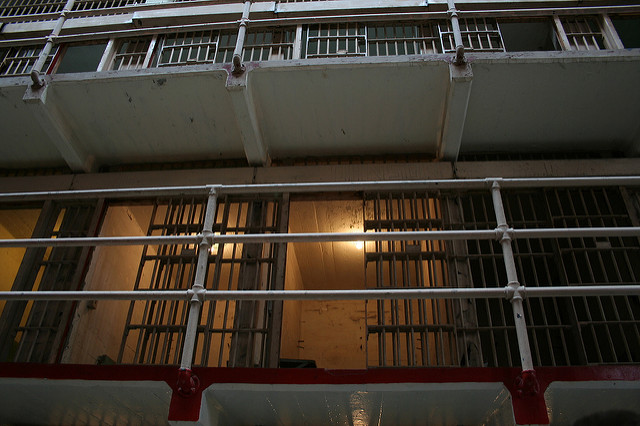Is Prison a Protective Factor for Homicide Victimization?

As I’ve been working on my doctoral dissertation, I’ve come across a few interesting homicide cases in Baltimore. They’re interested in that the victims had a chance to avoid being at the place and time when they were killed. They had that chance because of their own criminal activity. In essence, they should have been jailed but were not.
Kinlaw “Baby Boy” Jones
Mr. Jones was 19 years old when he and two other people got into a fight with a marine reservist in Baltimore. The fight ended in the reservist being stabbed to death. Mr. Jones and another person pled guilty to assault charges and testified against the third assailant. The judge sentenced Mr. Jones to five years of prison, with all but time served suspended. That is, Mr. Jones was free to walk out of jail the minute he was sentenced. (Read the full story here: http://articles.baltimoresun.com/2008-06-11/news/0806100250_1_rasin-final-fight-crosby)
About two years later, at age 21, Mr. Jones was shot dead by Antonio “Dollar” Edwards in a crowded nightclub area of Baltimore. Mr. Edwards pled guilty to possession of the gun, a federal crime because of the nature of the gun, and then pled guilty to the murder in state court. He will serve two 25-year sentences concurrently. (Read the full story here: http://www.baltimoresun.com/bs-mtblog-2011-06-unusual_plea_puts_killer_in_pr-story.html)
Other Cases
I also wrote about other cases back in January:
“On January 24, the Baltimore Police Department posted an announcement on their Facebook page that there had been an incident where two men were found with gunshot wounds. One of those men, Kelvin Armstead, died at the hospital from his injuries. He was 34 years old.
That wasn’t the first time Mr. Armstead had been in the presence of a gun. Ten years ago, Mr. Armstead is alleged to have been one of three men who killed Ricardo Paige.“
Mr. Armstead was sentenced to life, but was released at some point, only to get killed.
Also, the first homicide of 2017 had a similar story:
“As with Mr. Armstead, Mr. Pearlie had been in the presence of a gun before. Back in December of 2015, Baltimore Police posted on Facebook that they had arrested Mr. Pearlie with a loaded weapon. That post has been deleted in the last month. However, here is the court record of the arrest.”
Observations
These cases highlight several things. First, the justice system is not reforming prisoners. That shouldn’t be a surprise. The US justice system abandoned reforming or rehabilitating offenders sometime ago, focusing now on punishment:
“Until the mid-1970s, rehabilitation was a key part of U.S. prison policy. Prisoners were encouraged to develop occupational skills and to resolve psychological problems–such as substance abuse or aggression–that might interfere with their reintegration into society. Indeed, many inmates received court sentences that mandated treatment for such problems.
Since then, however, rehabilitation has taken a back seat to a “get tough on crime” approach that sees punishment as prison’s main function, says Haney. The approach has created explosive growth in the prison population, while having at most a modest effect on crime rates.
As a result, the United States now has more than 2 million people in prisons or jails–the equivalent of one in every 142 U.S. residents–and another four to five million people on probation or parole. A higher percentage of the population is involved in the criminal justice system in the United States than in any other developed country.
Many inmates have serious mental illnesses. Starting in the late 1950s and 1960s, new psychotropic drugs and the community health movement dramatically reduced the number of people in state mental hospitals. But in the 1980s, many of the mentally ill who had left mental institutions in the previous two decades began entering the criminal justice system.
Today, somewhere between 15 and 20 percent of people in prison are mentally ill, according to U.S. Department of Justice estimates.
“Prisons have really become, in many ways, the de facto mental health hospitals,” says former prison psychologist Thomas Fagan, PhD. “But prisons weren’t built to deal with mentally ill people; they were built to deal with criminals doing time.””
So people have an encounter with the prison system and it’s not used as an opportunity to set them straight. They are many times returned right out into the dangerous environment where they came from without much of a way out. That is, if they ever are put into prison to begin with, because that prisoner overpopulation leads me to my second point.
What was the point of sentencing Mr. Jones to five years if his sentence was going to be suspended? Sure, according to the court records being reported, Mr. Jones didn’t participate in the homicide. He was there as part of a bigger fight between all involved. But he just did some time while he was arrested and the trial took place. That was it. There was no real punishment for being involved in an activity that led to the death of someone. Others looking at Mr. Jones might figure that they themselves could get away with being in a deadly fight.
Finally, saying that prison is protective muddies the point that I’m trying to make. That’s because going to prison doesn’t help the great majority of people to become non-criminals once they’re out. If anything, there is plenty of evidence that they come out at higher risk of becoming criminals because of the social connections they make in jail, the lack of social connections once they are out, and the social stigma that leads to underemployment/unemployment and a return to crime. Still, I can’t help but wonder if they would still be alive had they still been in jail or served the entirety of their sentences… Or would their incarceration only delay the inevitable?
Featured image via Sara on Flickr (CC BY-ND 4.0)